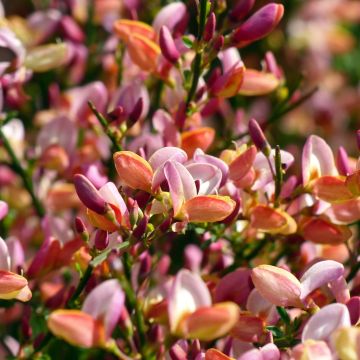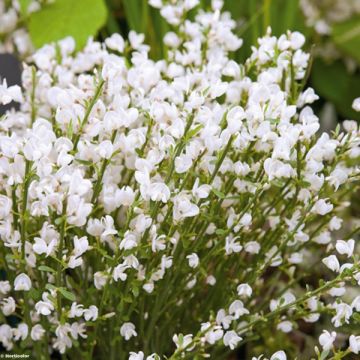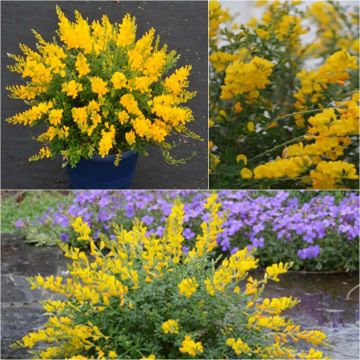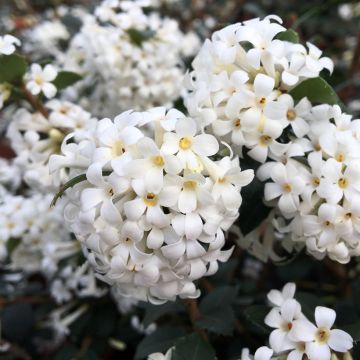

Genista pilosa Vancouver Gold - Genêt poilu
Genista pilosa Vancouver Gold
Genista pilosa Vancouver Gold
Hairy Broom, Bristly Greenbrier
This item cannot be shipped to the selected country
Delivery charge from €5.90
Delivery to Corse prohibited
More information
Schedule delivery date,
and select date in basket
This plant carries a 24 months recovery warranty
More information
We guarantee the quality of our plants for a full growing cycle, and will replace at our expense any plant that fails to recover under normal climatic and planting conditions.
From €5.90 for pickup delivery and €6.90 for home delivery
Express home delivery from €8.90.
Delivery to Corse prohibited: UE law prohibits the import of this plant from mainland France to Corse as part of the fight against Xylella fastidiosa. Please accept our sincere apologies.
More information

Does this plant fit my garden?
Set up your Plantfit profile →
Description
Genista pilosa 'Vancouver Gold', also known as Hairy Broom, is a small deciduous bush that thrives in full sun with a rounded and prostrate habit, making it an excellent ground cover. In late spring and early summer, it practically disappears under its abundant and sparkling golden yellow flowering. Appreciated for rock gardens, slopes, borders, and flowerbeds, it will create a beautiful golden cascade if grown in a container on a terrace. Very hardy, tolerant of various soil types, resistant to drought and salt spray, this creeping broom will find its place in a dry coastal garden as well as in most regions.
The Genista genus includes about a hundred species belonging to the legume family. They are shrubs that can be deciduous or evergreen, but their branches remain green and decorative all year round. Genista pilosa is a shrub with a prostrate or semi-erect habit, forming well-filled cushions. It has hairy and ascending stems, covered with discreet dark green foliage. The leaves are deciduous, simple, alternate, and very small, ranging from 0.5 to 2cm (0.2 to 0.8in) long. They have a silky hair on the underside. The 'Vancouver Gold' variety of Genista pilosa shares many similarities with the species. However, it distinguishes itself with its rounded and prostrate habit, forming a fairly regular creeping bush. Its branches spread up to 1m (3ft 4in) in width while its height is limited to 45cm. The Hairy Broom 'Vancouver Gold' makes an excellent ground cover as its vegetation is dense and carpeting. In late spring and early summer, Genista pilosa is adorned with a generous bright yellow flowering, composed of small pea-like flowers measuring 0.5 to 1cm (0.2 to 0.4in) long, arranged in long clusters of 7 to 15cm (2.8 to 5.9in). The flowering of the 'Vancouver Gold' variety is exceptionally radiant. From May to June, and even until July, the shrub literally disappears under a profusion of bright lemon yellow flowers. This dazzling flowering abundantly illuminates its space, even on grey days!
Genista pilosa is native to southern Europe where it naturally grows in forests and heathlands, sometimes up to an altitude of 1300m (4265ft). It is present throughout the French territory as it resists both drought and cold weather. Indeed, it can withstand temperatures of at least -15°C (5 °F) and is one of the hardiest shrubs in its genus. But it is also a must-have for dry and Mediterranean gardens as it has significant resistance to drought and heat. Genista pilosa prefers sunny or slightly shaded locations, poor and well-drained soils with an acidic tendency. It can still tolerate limestone soils but may develop chlorosis. Apart from its aversion to windy spaces and transplantations, it is a vigorous shrub that can live for many years without difficulty. Watering is unnecessary except in prolonged drought or heatwaves. To maintain a dense and rounded habit, prune it every year before the start of vegetation, from February to June. Be careful to prune only the young wood as Brooms flower on the previous year's wood. This operation will promote the branching of the shrub and, at the same time, the flowering of the following year.
Genista pilosa 'Vancouver Gold' is used as a border plant and in rock gardens, but it can also cascade down a slope. It pairs well with Mediterranean plants such as lavender, Grevillea juniperina, or Gaura Lindheimeri. In colder regions, you can accompany it with hardy perennials like Aster or St. John's Wort, which will take over the flowering after the broom in June. On a terrace or balcony, the Hairy Broom 'Vancouver Gold' will dress up troughs and pots with a charming golden cascade. Note that it is resistant to salt spray, allowing it to adorn any seaside exterior.
Report an error about the product description
Genista pilosa Vancouver Gold in pictures




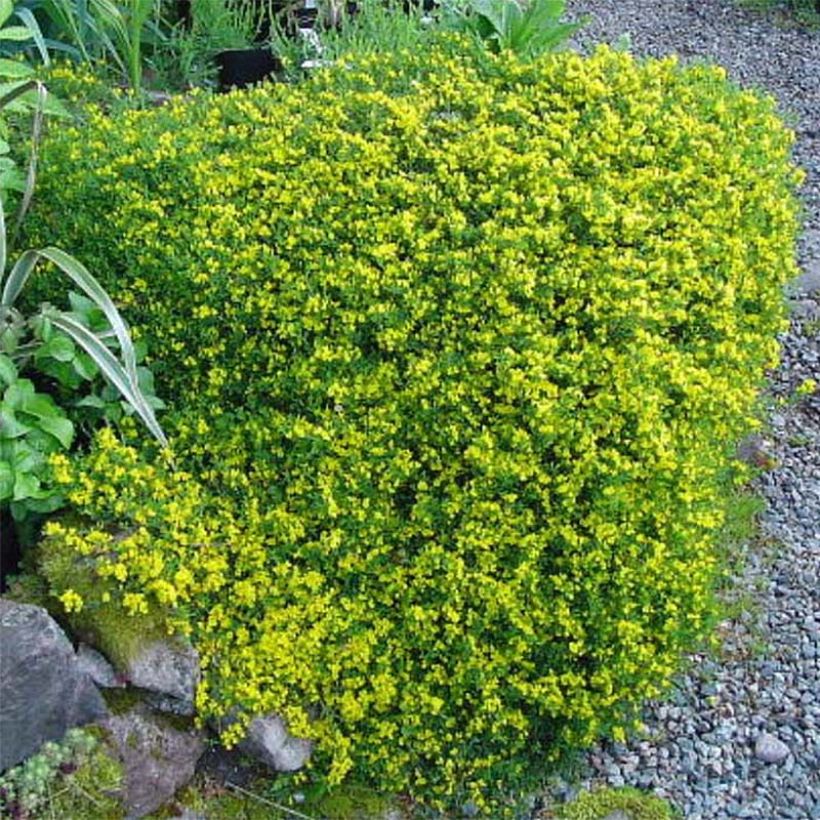

Plant habit
Flowering
Foliage
Botanical data
Genista
pilosa
Vancouver Gold
Fabaceae
Hairy Broom, Bristly Greenbrier
Mediterranean
Other Broom - Cytisus
Planting and care
Genista pilosa is native to southern Europe where it naturally grows in forests and heathlands, sometimes up to an altitude of 1300m (4265ft). It is present throughout the French territory as it can withstand both drought and cold: can withstand temperatures of at least -15°. It prefers sunny or slightly shaded locations, poor and well-drained soils, with a tendency towards acidity. The hairy broom can still tolerate limestone soils but may develop chlorosis there.
Aside from its aversion to windy spaces and transplantations, it is a vigorous bush that can live for many years without difficulty in cultivation. Watering is unnecessary except in case of prolonged drought or heatwaves.
To maintain a dense and rounded habit, prune annually before the start of vegetation, from February to June. Be careful to only prune the young wood as the Brooms flower on the previous year's wood. This operation will promote branching of the bush and, at the same time, flowering for the following year.
Planting period
Intended location
Care
-
, onOrder confirmed
Reply from on Promesse de fleurs
Spring-flowering shrubs
Haven't found what you were looking for?
Hardiness is the lowest winter temperature a plant can endure without suffering serious damage or even dying. However, hardiness is affected by location (a sheltered area, such as a patio), protection (winter cover) and soil type (hardiness is improved by well-drained soil).

Photo Sharing Terms & Conditions
In order to encourage gardeners to interact and share their experiences, Promesse de fleurs offers various media enabling content to be uploaded onto its Site - in particular via the ‘Photo sharing’ module.
The User agrees to refrain from:
- Posting any content that is illegal, prejudicial, insulting, racist, inciteful to hatred, revisionist, contrary to public decency, that infringes on privacy or on the privacy rights of third parties, in particular the publicity rights of persons and goods, intellectual property rights, or the right to privacy.
- Submitting content on behalf of a third party;
- Impersonate the identity of a third party and/or publish any personal information about a third party;
In general, the User undertakes to refrain from any unethical behaviour.
All Content (in particular text, comments, files, images, photos, videos, creative works, etc.), which may be subject to property or intellectual property rights, image or other private rights, shall remain the property of the User, subject to the limited rights granted by the terms of the licence granted by Promesse de fleurs as stated below. Users are at liberty to publish or not to publish such Content on the Site, notably via the ‘Photo Sharing’ facility, and accept that this Content shall be made public and freely accessible, notably on the Internet.
Users further acknowledge, undertake to have ,and guarantee that they hold all necessary rights and permissions to publish such material on the Site, in particular with regard to the legislation in force pertaining to any privacy, property, intellectual property, image, or contractual rights, or rights of any other nature. By publishing such Content on the Site, Users acknowledge accepting full liability as publishers of the Content within the meaning of the law, and grant Promesse de fleurs, free of charge, an inclusive, worldwide licence for the said Content for the entire duration of its publication, including all reproduction, representation, up/downloading, displaying, performing, transmission, and storage rights.
Users also grant permission for their name to be linked to the Content and accept that this link may not always be made available.
By engaging in posting material, Users consent to their Content becoming automatically accessible on the Internet, in particular on other sites and/or blogs and/or web pages of the Promesse de fleurs site, including in particular social pages and the Promesse de fleurs catalogue.
Users may secure the removal of entrusted content free of charge by issuing a simple request via our contact form.
The flowering period indicated on our website applies to countries and regions located in USDA zone 8 (France, the United Kingdom, Ireland, the Netherlands, etc.)
It will vary according to where you live:
- In zones 9 to 10 (Italy, Spain, Greece, etc.), flowering will occur about 2 to 4 weeks earlier.
- In zones 6 to 7 (Germany, Poland, Slovenia, and lower mountainous regions), flowering will be delayed by 2 to 3 weeks.
- In zone 5 (Central Europe, Scandinavia), blooming will be delayed by 3 to 5 weeks.
In temperate climates, pruning of spring-flowering shrubs (forsythia, spireas, etc.) should be done just after flowering.
Pruning of summer-flowering shrubs (Indian Lilac, Perovskia, etc.) can be done in winter or spring.
In cold regions as well as with frost-sensitive plants, avoid pruning too early when severe frosts may still occur.
The planting period indicated on our website applies to countries and regions located in USDA zone 8 (France, United Kingdom, Ireland, Netherlands).
It will vary according to where you live:
- In Mediterranean zones (Marseille, Madrid, Milan, etc.), autumn and winter are the best planting periods.
- In continental zones (Strasbourg, Munich, Vienna, etc.), delay planting by 2 to 3 weeks in spring and bring it forward by 2 to 4 weeks in autumn.
- In mountainous regions (the Alps, Pyrenees, Carpathians, etc.), it is best to plant in late spring (May-June) or late summer (August-September).
The harvesting period indicated on our website applies to countries and regions in USDA zone 8 (France, England, Ireland, the Netherlands).
In colder areas (Scandinavia, Poland, Austria...) fruit and vegetable harvests are likely to be delayed by 3-4 weeks.
In warmer areas (Italy, Spain, Greece, etc.), harvesting will probably take place earlier, depending on weather conditions.
The sowing periods indicated on our website apply to countries and regions within USDA Zone 8 (France, UK, Ireland, Netherlands).
In colder areas (Scandinavia, Poland, Austria...), delay any outdoor sowing by 3-4 weeks, or sow under glass.
In warmer climes (Italy, Spain, Greece, etc.), bring outdoor sowing forward by a few weeks.




































